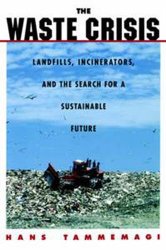Engineering Bookshelf
- Aerospace
- Biological
- Civil
- Chemical
- Environmental
- Electrical
- Materials
- Mechanical
- Petroleum
- Geoengineering
- Software

The Waste Crisis: Landfills, Incinerators, & the Search for a Sustainable Future
by Hans Y. TammemagiPublisher: Oxford University Press
ISBN: 0195128982
Check price @ amazon.com , amazon.ca , amazon.co.uk
Book Description
As populations continue to increase, society produces more and more waste. Yet it is becoming increasingly difficult to build new landfills, and the existing landfills are causing significant environmental damage. Finding solutions is not simple; the problem is enormous in size, vital in terms of its impact on the environment, and complex in scope.
This book provides a vast look at solid waste management in North America and seeks solutions to the waste crisis. It describes the magnitude and complexity of the problem, focusing on municipal wastes and placing them in the perspective of other wastes such as hazardous, biochemical, and radioactive debris. It describes the components of an integrated waste management program, including recycling, composting, landfills, and waste incinerators, and it presents in detail the scientific and engineering principles underlying these technologies. To illustrate both the problems and solutions of waste management programs, the authors provide seven case histories, among them the Fresh Kills (Staten Island, New York), the East Carbon Landfill (Utah), and the Lancaster County Municipal Waste Incinerator (Pennsylvania).
The Waste Crisis is unique in its attempt to analyze waste management in a broader societal context and to propose solutions based on basic principles. And by doing so, it encourages readers to challenge commonly held perceptions and to seek new and better ways of dealing with waste. As such, this book deserves a place on the bookshelf of anyone who deals with or feels the need to confront the growing problems of waste management.
Book Reviews
"A realpolitik book on the need for recycling to reduce waste, landfills for what can't be recycled, and incinerators when approrpiate....The best overview." - Whole Earth
"This textbook examines solid waste management in North America and solutions to the waste crisis, using seven case studies for illustration. The focus is on municipal waste, but this is placed in the perspective of hazardous, biomedical, and radioactive wastes as well." - SciTech Book News
"Hans Tammemagi does the almost unimaginable: takes a subject as inherently unappealing as garbage, and makes it interesting and relevant. His book is thoroughly researched, well written, and, despite the seriousness of his timely topic, surprisingly readable." - Niagara Book Prize Short List Jury
"Chapters discuss garbage through the ages, the age of consumerism and the waste explosion, integrated waste management, recycling and composting, waste characteristics, alternative disposal methods (existing and abandoned mines, landfill reclamation to extend the lifespan of old dumps, ocean dumping, deep-well injection, deep injection of liquid waste in cement slurry form, sub-seabed disposal), incineration issues, containment and encapsulation, case histories, siting problems of NIMBY and BANANA (Build Absolutely Nothing Anywhere Near Anyone), and a new approach that considers human health and the environment, future generations, and conservation of resources. A concluding chapter, Futuristic Garbology, presents an ideal vision of waste in 2032 ... A simply-written textbook that seems to cover all points." - Future Survey
About the Author
Hans Y. Tammemagi Head of Oakhill Environmental; Adjunct Professor in the Department of Earth Sciences Brock University
Customer Reviews
By Martha Maulidia
This book is just as fascinating as its title, that attracts much attention especially for the people dealing with waste management. To read it, one needs to be patient enough until find the most interesting chapters, which are the half last chapters. The several first chapters describe one by one facts why "monstrous" landfills are not suitable anymore for waste disposal alternatives, depicting the wide experience and knowledge of the author. It is written based on his experience in waste management activities in North America. In the end of every chapter, there topic discussions and assignments that make the readers actively involved in tracing the problems and seek for the solutions. The interactive style of each sentence also lets the reader think and try to argue or agree with the opinion of the author. For people that familiar with waste problems, introduction chapters seem queit boring, but the systematical explanantion makes it still worth to surf.
The beginning of the interesting parts of this book is the 8th chapter, "Are there better disposal methods?" The most creative ways ever are suggested, from the "make sense" one like deep underground disposal and landfill mining accompanying by incinerator and recycling program, until "exotic solutions" that includes "shooting out the waste into outer space". It seems funny, but, who knows it could be alternative that no one ever thought before. The deep comprehensive experience is shown once again in chapter"NIMBY" (Not in My Back Yard), describes the reason behind lack of communication between private and government with local people whose their settlement is to be a waste treatment or disposal area.
Just like the author said, theory is fine, but practical experience is the heart of real learning, this book also provides case studies, ranging from Canada, New York, until success story in Sweden. The verz last part, shows the vision not only of the author, I think, but of all human race wanting desparately for better future, with green, clean, organized environment.